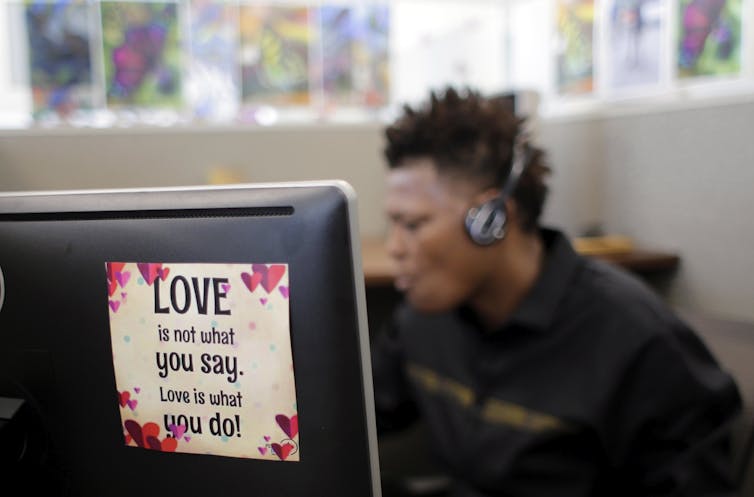Domestic abusers use tech that connects as a weapon during coronavirus lockdowns
- Written by Alison J. Marganski, Associate Professor & Director of Criminology, Le Moyne College
The coronavirus pandemic has driven much of daily life – work, school, socializing – online. Unfortunately, perpetrators of violence against women and girls are also increasingly turning to technology in response to the pandemic.
Globally, violence against women and girls is a problem of pandemic proportions, with one in three[1] experiencing an act of physical or sexual violence in her lifetime[2]. Most of these acts of violence are perpetrated by intimate partners and family. In the United States, women are at increased risk of violence from a current or former intimate partner[3], and they are more likely than men to suffer injuries[4], be treated in emergency rooms[5] and be killed[6] as a result of intimate partner violence.
Violence against women and girls is costly[7] for victims and their families, communities and society. The problem is complicated by new technologies, and now COVID-19.
Left unchecked, violence against women and girls can increase in frequency and severity[8] and damage victims’ physical and mental health[9]. It can also place children who are exposed to the violence at risk for behavioral issues, including delinquency and violence[10]. And it can be lethal, as highlighted by homicide by intimate partners[11], homicide by strangers[12] and even mass murders[13].
Technology and violence
 U.S. Rep. Katherine Clark, D-Mass., is the sponsor of a bill aimed at curbing online harassment and abuse.
AP Photo/Stephan Savoia[14]
U.S. Rep. Katherine Clark, D-Mass., is the sponsor of a bill aimed at curbing online harassment and abuse.
AP Photo/Stephan Savoia[14]
Pre-COVID-19 research shows that approximately 75% of women and girls experience cyber or technology-facilitated violence,[15] which is often misogynistic, hostile or both in nature.
Recipients of online harassment[16], image-based abuse such as “revenge pornography[17]” and other digital transgressions[18] experience them not only on social media[19] platforms but also in the home. These experiences include text message[20] or online threats of death or rape, harassment, monitoring and stalking[21] by a current or former intimate partner[22].
Technology-facilitated violence is the most common type of intimate partner victimization[23], and it accompanies in-person psychological, physical and sexual violence. It’s also linked to physical, psychosocial and behavioral problems[24].
The COVID-19 factor
Since COVID-19, reports of intimate partner violence[25], child sexual exploitation[26] and other serious crimes suggest a surge[27] in offenses.
Public health officials are asking people to socially distance and stay at home. These policies isolate women and girls from sources of support and place them in contact with abusers for extended periods of time without reprieve, which worsens control and abuse[28].
Technology-facilitated forms of control and abuse, like disabling phone or internet services and monitoring electronic communications, are particularly damaging during pandemic lockdowns. Many other digital transgressions[29] including livestreaming child sexual abuse[30], nonconsensual photo sharing and forced pornographic consumption, are exacerbated by the combination of technology, time and isolation.
Abusers have also used technology and the pandemic in efforts to cover up their crimes. In one case, a man disabled location services on his wife’s phone and used her text messaging services[31] in an unsuccessful attempt to fool her family into thinking she was alive. He was ultimately arrested for her kidnapping and murder.
Additionally, there are countless nonlethal acts of partner violence relating to COVID-19[32], including threats of eviction for coughing[33], forced physical contact during times of isolation and refusal to share soap or hand sanitizer, among other behaviors designed to gain power and control.
Adults aren’t the only victims during the pandemic. As children stay home from school and spend more time online, they may fall victim to predatory loved ones and online strangers. Reports of online child sexual abuse[34] are on the rise.
The system comes up short
There are few resources to keep women and girls safe, and those that exist are commonly plagued with problems[35]. Police, courts and corrections officials historically have failed survivors by blaming the victim, dropping charges and not attempting to rehabilitate offenders. They have also failed to take appropriate action[36] in most cases of cyber violence against women and girls.
Budget cuts are creeping into already underfunded homeless shelters, domestic and sexual violence hotlines, community outreach and related human services in some of the most populous states, including New York[37] and California[38].
Technological solutions like improved digital device security, abuse-aware technology design[39] that distinguish users from others based on visual or behavioral cues[40] and two-factor authentication to online services are not yet widespread. At the same time, online providers have not done enough to curb harassing behaviors[41]. All of this is detrimental to public health, especially for vulnerable populations.
 An advocate works in the National Domestic Violence Hotline center’s facility in Austin, Texas.
AP Photo/Eric Gay[42]
An advocate works in the National Domestic Violence Hotline center’s facility in Austin, Texas.
AP Photo/Eric Gay[42]
How to respond
There are several ways to address COVID-19, technology and interpersonal violence.
Domestic violence agencies need to reach people at home. Local and national domestic violence hotlines[43] and online chat services can promote their services via Hulu and Facebook ads, Roku background screens, Google homepages and local news. Agencies can also conduct surveys to learn about vulnerable people’s communication preferences. Insurance companies and local and state governments can offer telehealth visits, and social service agencies can reach people in crisis online.
Access to technologies like domestic violence apps SmartSafe+[44] and Circle of 6[45] can help victims with collecting and storing evidence that can be used in later criminal justice proceedings. They can also provide immediate access to local and national rape crisis hotlines and resources. Also, tools like Take Back the Tech![46] map instances of violence against women and girls worldwide as a way for survivors to have their stories heard and call on others to take action.
Social media platforms can find innovative ways to connect users with key resources and services, as Twitter has done with its new search prompt (#ThereIsHelp[47]). They can also make it easier[48] to communicate difficult experiences while also reducing traumatizing images[49] that may harm survivors, family members, friends and others.
Technology by and for women
Developing regenerative technologies[50], which foster online kindness and empathy, and diversifying the tech field with women who research or are survivors of violence against women and girls could make a meaningful difference. It’s important to incorporate women[51] and their perspectives in technological work. It’s also important to find ways for women and girls to maintain connections and interact safely online while social distancing.
Considering the possibility for continued and future outbreaks, it’s imperative that women and girls have access to services and strategies – in person and through technology – at local, regional and national levels. By reimagining approaches to violence and safety, the health and social services systems can reduce violence against women and girls. They can also better support those who find themselves in peril as they navigate life during and after trauma in ways that are safest for them.
[You need to understand the coronavirus pandemic, and we can help. Read The Conversation’s newsletter[52].]
References
- ^ one in three (news.un.org)
- ^ lifetime (www.who.int)
- ^ violence from a current or former intimate partner (www.ncjrs.gov)
- ^ suffer injuries (www.ncjrs.gov)
- ^ be treated in emergency rooms (www.prisonpolicy.org)
- ^ be killed (www.nytimes.com)
- ^ Violence against women and girls is costly (eige.europa.eu)
- ^ frequency and severity (www.ncbi.nlm.nih.gov)
- ^ physical and mental health (doi.org)
- ^ delinquency and violence (www.ncjrs.gov)
- ^ homicide by intimate partners (vawnet.org)
- ^ homicide by strangers (www.nytimes.com)
- ^ mass murders (doi.org)
- ^ AP Photo/Stephan Savoia (www.apimages.com)
- ^ cyber or technology-facilitated violence, (www.unwomen.org)
- ^ online harassment (www.bbc.com)
- ^ revenge pornography (scholarship.law.bu.edu)
- ^ other digital transgressions (genderit.org)
- ^ social media (www.amnesty.org)
- ^ text message (www.daily-jeff.com)
- ^ stalking (www.justice.gov)
- ^ former intimate partner (www.npr.org)
- ^ most common type of intimate partner victimization (doi.org)
- ^ behavioral problems (doi.org)
- ^ intimate partner violence (www.dallasnews.com)
- ^ child sexual exploitation (www.equalitynow.org)
- ^ surge (www.cnn.com)
- ^ abuse (www.nbcnews.com)
- ^ digital transgressions (www.apc.org)
- ^ livestreaming child sexual abuse (www.npr.org)
- ^ a man disabled location services on his wife’s phone and used her text messaging services (www.nbcmiami.com)
- ^ nonlethal acts of partner violence relating to COVID-19 (www.bwjp.org)
- ^ threats of eviction for coughing (www.theguardian.com)
- ^ online child sexual abuse (ktla.com)
- ^ plagued with problems (genderit.org)
- ^ failed to take appropriate action (thewebindex.org)
- ^ New York (www.syracuse.com)
- ^ California (chronicleofsocialchange.org)
- ^ abuse-aware technology design (nixdell.com)
- ^ visual or behavioral cues (lifehacker.com)
- ^ have not done enough to curb harassing behaviors (research-repository.griffith.edu.au)
- ^ AP Photo/Eric Gay (www.apimages.com)
- ^ domestic violence hotlines (nnedv.org)
- ^ SmartSafe+ (probonoaustralia.com.au)
- ^ Circle of 6 (www.circleof6app.com)
- ^ Take Back the Tech! (www.takebackthetech.net)
- ^ #ThereIsHelp (www.wionews.com)
- ^ easier (www.wired.com)
- ^ traumatizing images (www.cnn.com)
- ^ regenerative technologies (www.scientificamerican.com)
- ^ incorporate women (theconversation.com)
- ^ Read The Conversation’s newsletter (theconversation.com)
Authors: Alison J. Marganski, Associate Professor & Director of Criminology, Le Moyne College

